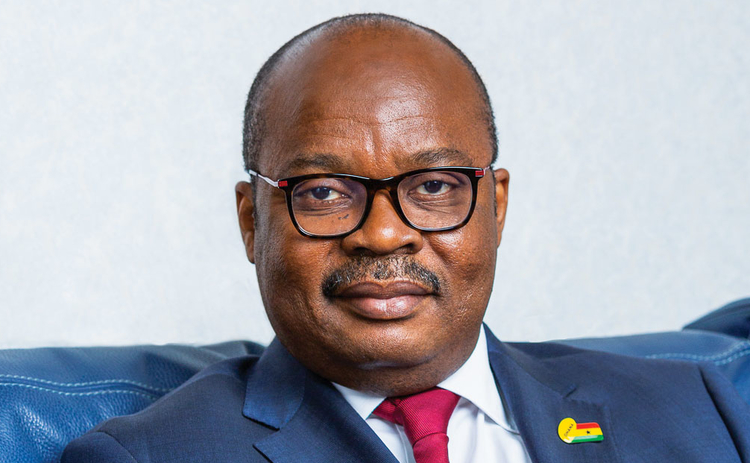PERISCOPE DEPTH …With Our Publisher
(This article was originally published in the Daily Searchlight of 24/02/2022)
I like Hausa kooko. Without sugar. Almost every morning, for many years now, it has been my practice to send to the lady at the junction to my house to buy Hausa kooko. Normally, I used to buy 0.70 Ghana cedis (seventy pesewas) every morning. Add a few cakes of koose, and I am ready to face the day.
A few weeks ago, I sent for my kooko, but after Madam served me with the dish, I decided to complain. I asked whether she was sure that that was seventy pesewas worth of kooko.
She laughed, “As for you! You still believe that we live in your old world. That is One Ghana cedi, not seventy pesewas. Prices of things are really going up.”
I looked again at the splash of kooko at the bottom of my bowl.
Are prices going up? Can I use my Kooko and Koose experiment to suggest that indeed prices are on the ascendency? That analysis would be similar to the analysis that the Minister of Agriculture is reported to have made recently, that if prices of food were on the ascendency, his wife would have told him. Well, I would be the first to admit that that type of analysis is rather unscientific.
But are prices on the ascendency? Is the Cedi able to buy all that it ought to be able to buy? Is the value of the Cedi the same, and therefore able to hold prices at a near constant?
To identify reliable data on the rate of inflation when it comes to prices, and the depreciation of the currency, one has to go to agencies like the Ghana Statistical Service, and the Bank of Ghana to get access to such data. However, from my experience as an Editor, I have found statements from these two institutions notoriously hard to decipher for the ordinary man. Communication from these institutions are written in such a way as to be hard to decipher. The language used is deliberately obtuse, so as to confuse and mystify, and I realized that to get at the facts and what may be ailing the Cedi, I have to look for my information from other sources. The first reliable source I identified was the Report of the Auditor-General for the year 2020. In that report, the Auditor-General employed the exchange rate of GHC5.71 as at December 2020.
That led to the next reasonable question; what was the rate of exchange (cedi to dollar) as at today (16:50 pm, Tuesday, February 23, 2022)? My google search put it at GHc6.60 to the United States dollar. That means that since December, 2020, to February, 2022, the Cedi has lost 0.89 pesewas in value compared to the United States dollar. In percentage terms, using the December rate of GHc5.71 as a base, the cedi has fallen by 15.59%. Now, I know that many of the economic ‘whiz kids’ who tend to trend government information would describe this as a wonderful performance by the Cedi, but in actual terms, at least against the United States dollar, in a period of little more than a year, the Cedi has lost 15.59%. of its value, by my extrapolation above. If the Ghana Cedi were to lose 15.59% every year, it would mean that in ten years, it would slide by about 150 percentage points in nominal terms. That means that every year, depending on where the Cedis ‘started’ with a base figure, it would slide by an average of 15.59%, all things being equal. How to calculate and reach that the actual figure ten years ago hence, is a matter to be left to those who passed econometrics. I am famously uncomfortable with that subject.
But that question led me inexorably to ask the question; where did the Ghana Cedi start? In our current history, the Ghana Cedi can be said to have ‘started’, that is with an identifiable base figure, on 1st July 2007, the date of the exercise we call ‘redenomination’, where the current currency of the country, the Cedi (¢), was redenominated to the Ghana Cedi (GH¢), such that ten thousand Cedis will be equivalent to one Ghana Cedi.
Recently, I visited Sunyani in the Bono region, and I was shocked to hear our citizens in the outlying towns and villages referring the 50 pesewa coin as “5000” and the 1 Ghana cedi note as “10,000”. To them, the value very much remains the same.
Redenomination, in case you have forgotten, is the artificial process we adopted in 2007 to rub four zeroes off the back end of the then “10,000.00” cedi note, so that it became ‘1”, and to insist that even though the zeroes were gone, the value was the same. In other words, the new “1 Ghana cedis” could buy whatever the 10,000 old cedis could buy. The value would be the same.
I recall, on a radio program on Peace FM, speaking to my longtime friend and brother, Kwami Sefa Kayi (we set out on the journalistic path together at a famous but now defunct newspaper called P&P), posing the question; how did the zeroes arrive at the end of the cedi in the first place? Have we addressed the underlying causative factors that brought the zeroes? Because, you see, if those factors have not been addressed, I argued, the zeroes, even if we wipe them off, would surely find a way of coming back. The zeroes at the end of the Cedi had arrived by a process of ‘natural attrition’, and unless that phenomenon of ‘natural attrition’ was addressed, the zeroes would find their way back. I said that water would always find its own level, I argued. At the time, I was talking to Ghanaians, but I could have been talking to the wind. I could still be talking to the wind today. What should frighten us all, is the very great likelihood that a year from now, the Ghana Cedi may be retailing at about GHc10.00 to the dollar, officially. And in ten years, the zeroes we rubbed off would surely be back with a vengeance, and the Cedi would most likely exchange at more than GHc100 or more (worse) to the dollar. Mark my words, this is a very real possibility.
This is important, because we as a people have decided that we would import every basic item we use. In effect, once the Cedi falls against the dollar, the cost of goods and services would continue to rise. And people would continue to scream that times are tough. It doesn’t really matter which party is in government, times would continue to be tough.
What was the rate of exchange of the cedi, relative to the dollar, in 1960? In 1970? In 1980?
I do not have the data, but I am sure that when the Cedi started in 1965, it was at least as valuable, if not more valuable, than the dollar at the time. My search on google revealed this valuable and very, very instructive paragraph from Wikipedia, “The African name Cedi (1965-1967) was introduced in place of the old British pound system. Ghana’s first President Dr. Kwame Nkrumah introduced Cedi notes and Pesewa coins in July 1965 to replace the Ghanaian pounds, shillings and pence. The cedi bore the portrait of the President and was equivalent to eight shillings and four pence (8s 4d), i.e. one hundred old pence, so that 1 pesewa was equal to one penny…. After the February 1966 military coup, the new leaders wanted to remove the face of Nkrumah from the banknotes. The “new cedi” (1967–2007) was worth 1.2 cedis, which made it equal to half of a pound sterling (or ten shillings sterling) at its introduction. Decades of high inflation devalued the new cedi, so that in 2007 the largest of the “new cedi” banknotes, the 20,000 note, had a value of about US$2.”
So, the Cedi started out in 1966 at a value of almost par to the dollar, or at least worth half the value of the Pounds Sterling. By 2007, it had fallen to C20,000 to the dollar.
The mother of all questions is; what disease afflicted that cedi, which caused it to fall so monumentally in 41 years (1966 to 2007)?
And the second lodestone question is; has that disease been eradicated?
From all indications, the Ghana Cedi started out at GHc.92 to the dollar in June 2007, and has now fallen to GHc6.60 to the dollar in February 2022. The surmise is that whatever disease was ailing the Cedi before June 2007, is still very much present.
This, is not a political matter, because the sickness of the Cedi has defied every economic and political manager of Ghana since Osagyefo Dr. Kwame Nkrumah.
So, to go back, how did it come about that a currency that was comparable in value to the Pounds Sterling in 1965, fall so badly that by 2007, you needed twenty thousand sheets of it to buy the United States dollar?
Thus it was, that in June, 2007, we decided to artificially rub off four zeroes, to bring the value of the cedi artificially closer to the dollar.
In fact, we did better than that. We actually valued our poor cedi higher than the dollar. One needed more dollars to buy the Cedi, because 1 dollar was worth 0.92 cedi. It is from that lofty height, that we now, as off this time that I am writing, buying one dollar with GHc6.60. This means that the cedi has tumbled end to end nearly seven times. If one was holding one cedi in 2007 and could buy one dollar with it, now, one needs about seven cedis of the very same cedi. In that scenario, you would be seven times or seven hundred percent poorer, through no fault of yours.
I am not an economist, but I am beginning to understand why so many people are saying that there is a pain in the economy. You can feel the heat, but you can’t find the source. Your salary disappears in two or three days (mine lasts less than a week, and I am well-paid) and then we have to resort to magic.
Now, assuming you are one of my people in Sunyani, and for you, the zeroes are still very real. You would say that you need 66000 to buy one dollar. This is against the fact that a mere fourteen years ago, you needed 9200 to buy the same dollar. The drastic reduction in value of the cedi, in the intervening period, led me to ask the question; what is the worst currency in the world, in terms of performance against the dollar?
Again, I resorted to my trusty old google, and here is what I found.
The absolute worst performing currency against the United States Dollar, is the Iranian Rial at a rate of 1 USD to 41994 Iranian Rial (IRR) (Source; https://in.lastminute.com/travel-magazine/cheapest-currency-in-the-world). That is the official rate.
Now, if we were to give the cedi its real value, the value my Sunyani brethren ascribe to it, that is 66,000 to one dollar, then it would surpass the worst performing currency in the world, the Iranian Rial.
Now, I am certain that we would have many people, including economists, disputing these conclusions. They are welcome. However, one bull in the room they would have to slay, is whether or not, the value is the same. Because if the value is the same, then GHc6.60, is equal to C66000, which is equal to one dollar which is a higher sum than 41994 Iranian Rial.
The worst currency in the world.
(This article was first published in the Daily Searchlight of February 24, 2022. The Daily Searchlight appears every day on the newsstands and for sale 24 hours every day and all week on www.ghananewstand.com. Visit www.ghananewstand.com for a wide variety of newspapers published in Ghana and from across the world.)









